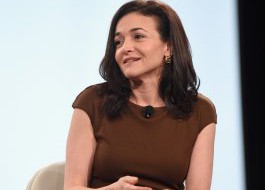 SherylSandberg.KimberlyWhite/Getty
SherylSandberg.KimberlyWhite/Getty
Sheryl Sandberg's husband died of a heart arrhythmia on aFriday evening.
They'd been vacationing in Mexico, and from the moment she sawhim on the resort's gym floor, a life built on relentlessorder — in the workplace, in the home, and especially inbalancing the two — was thrust into terrifying chaos.
She flew home and broke the news to her two young children. Shelistened to Bono perform "One" in front of 1,700 people crammedinto the Stanford Memorial Auditorium for a memorial. She spentseven days welcoming friends for the traditional Jewish shiva,accepting food she mostly didn't eat.
Then, on the following Monday, Sandberg dropped her kids off atschool, eased her SUV out of the parking lot, and headed forFacebook. Her boss — Facebook's founder Mark Zuckerberg — had encouraged her to take as much time as she needed beforereturning to work, but grief counselors had advised her to gether kids back to their regular schedule. She thought it wouldbe good to return to work while they were at school. "I wantedout of my house," she says, thinking back nearly two years. "Imean, I love my job."
As Facebook's chief operator, Sandberg holds one of the mosticonic jobs in tech. She's the most famous number two to haveever existed, and she's famous because of what she has managedto achieve. In the nine years since she joined Facebook,Sandberg launched an ad business that has led the company to beworth $408 billion, helped take the company public, wrote abest-selling book on women in the workforce, and helmed amovement by the same name: Lean In. When other promising techstartups reach their adolescence and their young male foundersneed help, they often put out a public call for a SherylSandberg.
Along the way, Sandberg has pioneered her own approach toleadership, the hallmark of which has always been the kind ofopenness that Facebook prizes. In multiple commencementspeeches, she has implored graduates to "bring your whole selfto work," saying, "I don't believe we have a professional selfMonday through Friday and a real self the rest of the time. Itis all professional and it is all personal."
Sandberg's whole self was always a bit more polished thaneveryone else's. She was a paragon of efficiency. Sheremembered names. She hosted dinner parties in her home,seamlessly multitasking so she could put her kids to bed andthen join three dozen Silicon Valley women for a salon.
As former Treasury Secretary Larry Summers, who taught Sandbergat Harvard and later hired her as his chief of staff, once toldthe The New Yorker, "Sheryl always believed that ifthere were thirty things on her to-do list at the beginning ofthe day, there would be thirty check marks at the end of theday."
Then she lost her husband. On that morning that she firstreturned to work, as the dry hot Menlo Park sun came out andthe cars turned into the parking garage beneath Building 20,she wasn't thinking about her Lean In fan base, or thethousands of young Facebook employees who looked up to her. Theimage of her husband on the gym floor kept flashing across hermind like a sick and twisted augmented reality. "All I wantedto do was survive," she remembers.
By her own account, the day did not go well. She fell asleep ina meeting. In another, she talked about having worked with acolleague at Google; he'd actually worked for its competitor,Microsoft. In still another, she heard herself rambling. "Ikept going, I couldn't stop," she said.
And as her words filled the air, her fears began to spiral.Maybe she'd lost her edge. Maybe she'd have to quit, or worse,be sidelined or fired. Just like that, Sandberg, thewoman who'd written the book on confidence, had none.
On the first Friday in April, I visit Sandbergat Facebook headquarters. She's dressed in jeans and a tansweater, her husband's wedding ring dangling from a chainaround her neck. She joins me in her glass conference room,pulling her legs up beneath her in an Aeron chair.
I've interviewed her many times over the last few years; shehas changed. She's calmer. It's true of her kids, too, shesays. Recently, her son's team lost the basketball playoffs."Everyone else is super upset," she says. "I looked at him.He's like, ‘Mom, this is sixth grade basketball. I'm fine.'"
And that's what it is. Sandberg affects the air of someone whohas gained perspective — who looks around at Facebook's17,000 employees, all of the code-red emergencies, the legalissues, the clients whose names she must remember and thoseshe'd rather forget, and reminds herself that it's all someversion of sixth grade basketball, and she is fine. "I am abigger-picture manager because I've lived through somethingthat's a big picture," she says. "I can move on much faster."
This is the definition of resilience, the big idea behind hernew book. Dubbed Option B: Facing Adversity, BuildingResilience and Finding Joy, and cowritten with Whartonprofessor Adam Grant, it's a guide for anyone confronting thekind of straight-up hardship that renders everything elsetemporarily meaningless. The death of a husband, or a child. Asexual assault. Cancer.
 Knopf
Knopf
Sandberg never intended to grieve publicly. Whether driven byintuition or the smart counsel of friends like Grant, shesimply did everything she knew to feel better.
And because it's the way she operates, she felt compelled toshare what she'd learned about the hardest thing that has yethappened to her.
The more she shared, the more people — Facebook's employees;random strangers who'd experienced their own loss — reachedback to her, and their messages (often posted on Facebook) madeher feel less alone.
She doesn't profess to be an expert. Sandberg knows herexperience is uniquely influenced by her station in life. She'srich. She has important friends. Lean In has made herfamous.
Despite this, or maybe because of it, her sudden loss was metwith deep compassion by friends, employees, and beyond that,strangers the world over. Representatives of the White Houseexpressed condolences on her Facebook page. My mother, who hasnever met her, wept.
Ittook Sandberg falling apart completely for her to come up withOption B. She had to survive a loss that brieflyseemed insurmountable to bring us her next big idea. Inthe process, somewhat by accident because she felt she had noother choice she found a way to bring even more of her whole,messy, sad, intelligent, demanding, heartbroken self to work.
Even more than Option B is a self-help tome, it's amanagement book. Sandberg shows how a boss can lift a wholeorganization by admitting she (or he) needs help. Managementcoach Kim Scott, who authored the book Radical Candorand once reported to her at Google, says this skill isincreasingly important.
"What you have in the generation of leaders that Sherylrepresents is a move away from bureaucracy to relying on humanrelationships for managers to get things done," she says."That's in the air, here in Silicon Valley, and I think Sherylis largely responsible for it."
With Option B, Sandberg is becoming the advocate for aradical approach to office openness. Everyone knows that the20th century model of the Organization Man, characterless andrigidly devoted to the success of the corporation, is history.Work flexibility and individuality are in vogue.
Yet we still expect our colleagues to contain and conceal theirpersonal lives. Take five days' bereavement leave when a spousedies. Accept the company fruit basket that arrives in the mail.Return a week later and persist.
Tech companies have been at the forefront of new, more flexibleapproaches to work that give workers more leeway to managetheir personal lives. But we've all — everyone last one ofus — struggled with how to talk about hard things with eachother, at work and at home, and so often, we've reverted tosilence.
This is unacceptable to Sandberg. This year, Facebookinstituted a new 20-day bereavement leave for the death of aspouse. As important, Sandberg believes people can do a betterjob at supporting each other when they return. "I want peopleto help take care of each other at work," she says. "That'swhat I want. Do you know how many hours we spend at work? Wespend more time at work than we spend at home. When people aresuffering, we don't help enough."
On the evening of Sandberg's first day back,when her kids were in another room getting ready for bed, shecalled Zuckerberg to apologize. "I'm a disaster," she rememberstelling him. "I'm terrible. I fell asleep. I said stupidthings." Zuckerberg heard her out. But then, he told her he wasglad she'd come in. He mentioned two important points she'dmade. The mistakes? He joked they were mistakes she might havemade anyhow. It was a gentle assist that, she says now, helpedremind her she was capable.
Zuckerberg and Sandberg are close. On that awful Friday night,Sandberg had called him from the hospital, and he and his wifePriscilla came to her house when she arrived home the nextmorning. Zuckerberg planned the funeral. They'd spoken everyday since then.
 Emma McIntyre / Stringer / GettyImages
Emma McIntyre / Stringer / GettyImages
But while he checked in with her constantly once she returnedto the office, most others responded by giving her space. She'dshow up, and slip into meetings. But in between, no one spoketo her. People avoided eye contact when she walked by. Or,they'd ask, "how are you?" It was a well-meaningquestion with an obvious answer: How did they thinkshe was? Her husband had died. She'd slip into her conferenceroom, pull her blinds down, and cry. "It felt quiet andisolating and sad and scary," she says.
The silence and awkwardness wasn't for lack of caring. AmongFacebook's employees, Sandberg is largely revered. One dayshortly after her husband passed, employees organized agathering in Facebook's internal courtyard, Hacker Square, foran extended moment of silence. Yet up close, people weretongue-tied around her, not knowing how to help. Lori Goler,who runs human resources, recounts driving by Sandberg's house,unsure of whether to stop and go in.
The isolation felt unbearable. "Three weeks sounds short unlessyou're living this," Sandberg said, adding that early on,"living through a day felt like an eternity." To cope, shewrote in her journal, filling up pages with reflections,letters to her husband or her kids, or things she wanted totell the other parents at their school.
Thirty days after Goldberg's funeral marked sheloshim,the end of the Jewish period of mourning for a relative. Thenight before, Sandberg penned a Facebook post to mark the day.She did it in haste, without overthinking her words, intendingit primarily for people she knew — colleagues, casualfriends, other parents. Reading it over, she decided it was toopersonal to post.
The next morning, she woke up feeling awful. She reconsideredposting her essay. "I was like, ‘It can't get worse. It mightget better,'" she remembers.
So she clicked the blue "Post" button.
The post, whichlent her book its name, was her inspirational stake in theground for a future of meaning and life. "I think whentragedy occurs, it presents a choice. You can give in to thevoid, the emptiness that fills your heart, your lungs,constricts your ability to think or even breathe. Or you cantry to find meaning," she wrote. Her piece was a lyricalreflection on the places she'd found comfort, and the thingsshe'd discovered.
"I have learned that I never really knew whatto say to others in need," one paragraph began, offering adviceon what felt okay to talk about. "When I am asked ‘How areyou?' I stop myself from shouting, My husband died a month ago,how do you think I am? When I hear ‘How are you today?' Irealize the person knows that the best I can do right now is toget through each day."
It's not an exaggeration to say that nearly everyone I knowread that post. Today, it has more than 74,000 comments,including notes from colleagues, peers in tech, friends, andstrangers who read her words and recognized their own truths.
After that day, Sandberg's colleagues started talking to heragain. She had taught them what to say.
Every year in late May, Facebook gathers itspolicy and communications team for a day-long retreat.Employees fly in from satellite offices in Germany, say, orJapan. It's a chance to address problems, and set strategy forthe year to come.
Sandberg always speaks, but that year Caryn Marooney, who wasthen in charge of technology communications, remembers everyonetold her she could skip it. She insisted on coming anyway. As200 people looked on, she began telling the group what she wasgoing through, and how it was. "There were a lot of tears. Itwas incredibly raw, and then she said, "I'm going to open it upto Q and A," Marooney remembers. People spoke up.
Talking about her situation allowed Sandberg — and the entireteam — to move past it and transition into a productiveconversation. Having acknowledged the proverbial elephant inthe room, they could all focus on the work at hand. "I thinkpeople think that vulnerable is soft, but it's not," saidMarooney, as she described Sandberg's tough approach tobusiness questions that followed. "It was a blueprint of whatwe saw from Sheryl going forward."
Sandberg also brought this approach to one-on-one meetings.Around campus, she is credited for Facebook's check-ins, inwhich people start gatherings by reporting on how things aregoing, personally and professionally. "For those first sixmonths especially, just about every one of our weeklyone-on-ones involved some period of crying and talking aboutthe pain," says David Fischer, who runs business and marketingpartnerships for Facebook.
Fischer has worked with Sandberg now for two decades — first atthe US Treasury Department, then Google, and now Facebook —which is to say that they'd mastered the dynamics of theirworking relationship. And yet Goldberg's death shifted them,forging a deeper closeness.
"Certainly, anyone who's known me a long period of time wouldsay I was someone who usually had that wall up unless I knewyou really well," he says. "I learned, ‘Why am I doing that? Idon't think I'm helping myself…and I'm not protecting people."He found himself sharing his own feelings with the people hemanaged.
Sandberg believes there's a sound business reason forencouraging this openness. Research suggests she's right. In a2016episode of the podcast Invisibilia, HannaRosin tells the story of what happened when, in the late 1990s,Shell began its first attempts at deep water drilling, whichwas a far more dangerous pursuit than earlier endeavors.
Oil rig workers have a machismo culture. A leadership coachapproached Shell and suggested trainings to open workers upemotionally. The men were initially hostile when asked to, say,draw pictures of their family or share stories about analcoholic father.
But as one or two people began to change, others joined in andthe dynamic of the room switched. As the men became more openwith each other about their feelings, they began to communicatemore about other things like the technical information thathelps a rig run more smoothly. This led to an 84 percentdecline in accidents, according to an articlepublished about the work in Harvard BusinessReview.
As Sandberg writes in Option B, "When it's safe totalk about mistakes, people are more likely to report errors,but less likely to make them."
In January 2016, Marooney found out she hadbreast cancer. It took a while for doctors to confirm thediagnosis. "You keep coming back, and you know why you're goingback," she remembers. "You're just hoping that the end resultis ‘no.'" Instead, she was told she'd need surgery, and then asix-week daily course of radiation.
Shortly before the official diagnosis, Zuckerberg and Sandberglet Marooney know they wanted her to become the global head ofcommunications. It was an important promotion to a big job."This is the job that I wanted and worked for, for 20 years,"she remembers thinking. "What the f---?"
But that's not what she said. She confided in Sandberg that shethought she had cancer; if the results came back positive, sheplanned to turn the promotion down. "I just can't even thinkabout thinking about it, let alone thinking about doing a goodjob," she remembers saying.
Sandberg told Marooney not to decide, but to focus on gettingbetter. Marooney wasn't sure how she was even going to stay ontop of the job she had, though it was important to her to keepworking through her treatment. "For me, coming into work endedup helping me not make cancer my full-time job," she said.
Sandberg stepped in to help. "I was so overwhelmed, it would belike, ‘well, this presentation is the same day as a doctor'sappointment, so I have to quit,'" Marooney remembers. Sandbergwould suggest someone else give the presentation, or perhapsthey could reschedule it. "It was so simple, but I couldn't seeit," says Marooney.
 Philippe Wojazer/Reuters
Philippe Wojazer/Reuters
Once surgery was behind her, Marooney could once again think ofthe future. She really wanted that job. Radiation was stillahead of her, and she'd need to reduce her workload tohalf-days for awhile. But that would be temporary, and she knewshe could count on her colleagues' support. She accepted.
That May, the global policy and communications team hosted their annual offsite once more. Again, colleagues flew in. This was the first time Marooney would address the group as their new leader. She'd already been doing the job for awhile, yet she hadn't met many of them.
"My version of a new leader would have gotten on a plane and met all these teams," she said. "Instead, it's like, ‘Hey, I'm your new leader. A lot of you don't know me. I haven't reached out. I can't and I have cancer. I need a lot of help."
A year later, Marooney is in recovery. Her story is validating to Sandberg. "Had Dave not died, would she have told us all she had cancer?" she wonders out loud.
"I think we have this false and old-fashioned idea of what is professional and what is personal, as if we could go to work and put on a suit and be someone else. I've never believed that. You bring your whole self to work and that's where you find strength and resilience and you build relationships." In other words, your vulnerabilities, when shared, are your most effective tools for working with other people.
Sandberg always believed this, but now she has also lived it in its most extreme form.
And because of who she is, as the model of confidence and success for a generation of aspiring female leaders, and because of what Facebook is as a trendsetter in business culture, Sandberg is uniquely positioned to share this message, turning her personal healing into a new movement in how we all work.
And just maybe, starting a movement will help Sandberg survive her cataclysmic loss. Two years isn't a long time for anyone to place such an extreme event into context.
I ask Sandberg what she hopes to achieve with "Option B," and her answer is personal. It concerns her own healing process. "I'm doing this because I want meaning. I'm doing this because if something good doesn't come out of his death, and you knew Dave…" she says. She is choked up; we pause. "All this death and loss…If there is meaning, like any meaning, it's easier."
More from Backchannel:
The Insider Story of BitTorrent's BizarreCollapseHow Technology Led a Hospital to Give a Patient38 Times His DosageThe Internet Really Has Changed Everything.Here's Proof. An Exclusive Look at How AI and Machine LearningWork at AppleHow the Web Became UnreadableRead the original article on Backchannel. Copyright 2017. Follow Backchannel on Twitter.




